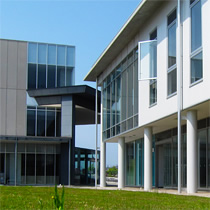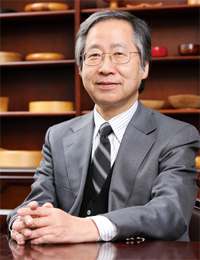First of all, I would like to express my deepest sympathies to all those who have suffered from the Great East Japan Earthquake on March 11, 2011.
In this column, I describe about (1) the Great East Japan Earthquake and the status of damage in TOHTECH, (2) response to disaster in TOHTECH, (3) Issues and points to look back on regarding appropriate measures to be taken in the event of a disaster and (4) what we can do toward post-disaster reconstruction.
1. The Great East Japan Earthquake and the status of damage in TOHTECH
The Great East Japan Earthquake, which occurred on March 11, 2011, was the biggest one ever to have hit Japan. It had a magnitude 9.0 with its seismic center on the seabed,. It also triggered a Mega-tsunami which destroyed many livelihoods, factories and facilities. In addition to that, it and the subsequent tsunamis caused a grave nuclear accident at the Fukushima No.1 Nuclear Power Plant. Owing to these disasters, about 15,000 persons were registered killed, 6,000 injured and 3,000 missing.
In TOHTECH, 5 students and 1 expected entrant were unfortunately killed by tsunami while they were home for spring vacation.
Regarding TOHTECH’s buildings and equipment damage, several cases of landslides and subsidence occurred in the campus; many cracks formed in both sides of walls, a number of lighting fixtures fell down from the ceiling in the gymnasium, various pipes and air-conditioners broke, and almost all of the furniture and bookcases in offices and classrooms were overturned.
The cost of this damages amounted to more than 600 million yen.
As with surrounding areas, university infrastructure was also hit directly by the earthquake. After the earthquake occurred at 14:46, TOHTECH’s supply of electricity, water and gas was cut. The University’s electricity and network systems were restored on March 14, just 3 days after the earthquake. The water supply was restored on March 26. Restoration of the gas supply was not completed until later.
2. Response of TOHTECH to the disaster
First, the disaster prevention measures carried out at TOHTECH before March 11 will be explained. Following inspections, campus buildings had been reinforced with steel frames & dampers, including pillars with fiber rolling developed by TOHTECH’s professors. As a result of these precautions, while furniture and bookcases were overturned in many offices, the buildings themselves were not greatly affected by the earthquake.
In addition, TOHTECH both students and faculty members, had , and continue to take part in regular drills, training and classes in disaster prevention. Finally, an Earthquake Early Warning (EEW) system had previously been installed in the campus.
When the earthquake occurred, we found ourselves experiencing a shaking such as we have never experienced before. After several shocks settled down, students and faculty members took refuge in the courtyard appointed as a shelter and meeting area, where roll call and identification were carried out. There was a comparatively small number of students present on that day, just 450, due to it being spring vacation. About 200 persons who could not return home were permitted to stay in the campus.
We confirmed the immediate plans of those who were left and closed the campus. Next, we established two emergency response headquarters, that is, ‘President team’ and ‘Secretariat team’. The President team was tasked with confirming the safety and responding to enquiries from students and their parents. The Secretariat team was tasked with responding to the needs of students and other people in the immediate area, securing articles and gathering information regarding the situation.
Physical and mental care of the 200 persons who had difficulty in returning home, and of 100 people in neighboring areas of the University was carried out. It was necessary to provide meals, lighting and heating. The Secretariat team, using emergency foods, diesel generators, and oil heaters gathered from various locations around the campus, made efforts to support these people.
Diagnosis and estimates of damage to University facilities and equipment were carried out by a contractor and faculty members. Entry to buildings was finally permitted on March 13.
On March 14, electricity was restored and power supply to every building, one by one, was achieved, paying attention to short-circuits or fires resulting from this process. The network server and portal site of TOHTECH were also restored at this time.
Among the measures taken immediately after the disaster, confirmation of student’s safety was classed as the most pressing and important task. It began 2 days after the disaster, by means of mobile phone, public telephone, e-mail and reporting face to face, Due to electric power failure, since there were no computers available at first, the names of students whose safety was confirmed was written on paper or whiteboard. Looking back now, these old-fashioned methods were a very reliable method.
After the recovery of electricity, we set up a temporary homepage on Google and started to use Gmail, through which more than 2,000 confirmations were sent. We achieved confirmation of 99% of the status of students in just two weeks.
On March 15, we determined to cancel the graduation ceremony and also the entrance ceremony scheduled for April 4. On March 25, two weeks after the earthquake, we determined to delay the beginning of classes for one month and decrease the number of classes. Then we determined the exemption or reduction of school expenses. These measures were applied to the students who have difficulty paying school expenses due to problems arising from the disaster.
We also implemented extra educational programs to make up for class time which had been lost. In each Department, faculty members responded individually to the students who were highly motivated to study or to work as volunteers. I strongly believe that the university, as an educational institution, should consider such educational programs like this as most important in cases of emergency.
3. Issues and points to look back on regarding appropriate measures in the event of a disaster
One issue is regarding the establishment of emergency response headquarters. It was determined that rather than following prescribed steps, roles and measures detailed in a manual, we should instead establish an organization which focuses on the “function” necessary at that moment.
Another issue is regarding the manner of confirming safety. From now on, we should consider the following measures:
・Installation of another server in (an)other area(s) on the presumption that school server will be damaged
・Making use of Cloud Computing
・Making full use of SNS (Social Networking Service) such as Twitter or Facebook etc.
Also, as a matter of course, it is clarified that securing fuel, water and securing toilet facilities are very important. Of these, due to the difficulty in obtaining gasoline for use in transportation and transfer, we realise the importance in securing its supply.
4. What we can do toward reconstruction
The duty of the universities is to investigate the following points:
・What ought to be the crisis management in case of disaster
・What technology is capable of doing to save lives and communities from a disaster
・How to educate those who will be able to deal with the crisis
I would like to introduce some practical approaches and efforts that have been established in TOHTECH to answer these problems.
First, Joint research projects for regional reconstruction have been introduced. Immediately after the earthquake, the Center of New Technology Creation and Research in TOHTECH invited the faculty to carry out research, following which, 17 supporting projects for reconstruction were adopted. 10 million yen of funds was put into these projects. The projects are divided into 4 fields: regenerating cities, promoting industrial development, survey and analysis, and revitalizing communities.
The next practical approach is the establishment of “Fukkou-Daigaku”.
Supported by the Ministry of Education, Culture, Sports, Science and Technology, Fukkou-Daigaku is based on the Gakuto-Sendai-Consortium to which all the universities in Miyagi Prefecture belong, and it has performed promotion services on “Development of human resources for reconstruction” and “Technological support for reconstruction”; TOHTECH acts as its organizer.
Another effort being made in TOHTECH is the foundation of “International Center of Disaster Engineering (ICDE)”. In April 2012, an international center was established for foreign students, including graduate students of TOHTECH aiming at “how technology saves lives and communities from a disaster”, in order that they too could learn general knowledge regarding disaster engineering.
Under the cooperative management of 3 special subject areas (Architecture, civil engineering and industrial design) within the graduate school of TOHTECH, the “Professional course for disaster-resistant city planning” was begun. It is aimed at giving students a broad knowledge of disaster engineering, and training them to be future leaders in Asia who will be able to cope with disasters that may occur in the future. It consists of 4 programs: (1) Planner Program, (2) Reconstruction Coordinator Program, (3) Structural Engineer Program, (4) Environmental Engineer Program.
5. Conclusions
Inconclusion, I’d like to summarize this column in four points.
(1) Faced with this disaster, largely while endeavors that the country as a whole had made such as making our buildings earthquake-resistant, the lack of preparations for tsunami and tremors on such a large scale-caused extensive damage to many areas.
(2) In TOHTECH, there were some problems reqarding the measures taken immediately after the Earthquake. We need to confirm the students’ safety more promptly, steadily improve the awareness of what to do in a crisis and organize a crisis management system.
(3) TOHTECH is located near a residential area, so it is necessary to form an organization for disaster prevention and what to do in the event of a disaster in cooperation with the local residents.
(4) As an educational and research institution, the most important thing is to train those who are able to deal with a crisis, and to investigate what technology is capable of doing to save lives and communities both before and following a disaster.






